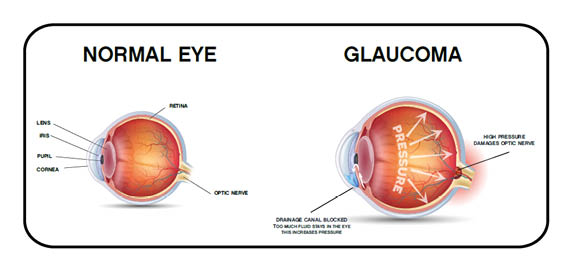- A-
- A+
Definition of glaucoma
Glaucoma is an eye disease that is characterized by loss of nerve tissue that results in vision loss. destroys the optic nerve. This nerve at the back of the eye (retina) transmits images to the brain.
Glaucoma causes irreversible damage to cells in the optic nerve. It only affects peripheral vision at first, but if left untreated, this disease will ultimately compromises the entire visual field.

Different types of glaucoma
There are several types of glaucoma:
- Primary open-angle glaucoma: this is the most commonly form of the disease (90% of cases). It is caused by blockage of the drainage channels in the eye, preventing aqueous humour from draining. Most often, it only becomes evident after it has been progressing for several years. It generally affects both eyes.
- Acute angle-closure glaucoma: it is rarer and may occur when the pupil dilates due to physiological reasons (stress, darkness, cold temperatures) or pharmacological ones (medicines). This causes pressure inside the eye (intra-ocular pressure) to increase suddenly and significantly, and the sufferer typically experiences symptoms such as severe eye pain and headache, vomiting, or sudden loss of sight. In this event, action must be taken immediately to prevent irreversible damage to the optic nerve.
- Secondary glaucoma: this type of glaucoma occurs as a result of trauma, eye disease, eye surgery or certain medical treatments (side effects).
- Congenital glaucoma: it can happen at the birth. It is an extremely rare condition associated with eye malformation.
- Normal tension glaucoma: this is a primary open-angle glaucoma, but with normal intra-ocular pressure (below 21 mmHg). It is diagnosed based on abnormalities in the visual field or optic nerve head, intra-ocular pressure below 21 mmHg, or an open angle.
Risks factors for glaucoma
Although the precise cause of glaucoma is not fully understood, several factors have been proven to make it more likely to occur:
- Increased intra-ocular pressure above 21 mmHg: this is the main factor. However, not all eye hypertonia (or hypertension) leads to glaucoma; conversely, glaucoma can occur even when intra-ocular pressure is normal (normal tension glaucoma).
- Age: glaucoma generally occurs after the age of 40, and it becomes more frequent as people get older.
- Short-sightedness; long-sightedness
- Hereditary: if a parent suffers from glaucoma, there is an increased risk that their offspring will develop the condition. The risk is increased if a parent suffers from glaucoma.
- Certain illnesses: arterial hypertension, diabetes, or prolonged intake of corticoid treatment may increase the risk of glaucoma.
Sources:
(1) La Revue du Praticien Médecine Générale, Volume 32, no. 998, March 2018.
(2) French Association of Qualified Ophthalmologists, Ophthalmology, Elsevier Masson, 2017.
(3) Ameli, Glaucome [online]. Available at: www.ameli.fr/assure/sante/themes/glaucome
(4) Inserm, Glaucome [online]. Available at: www.inserm.fr/information-en-sante/dossiers-information/glaucome



